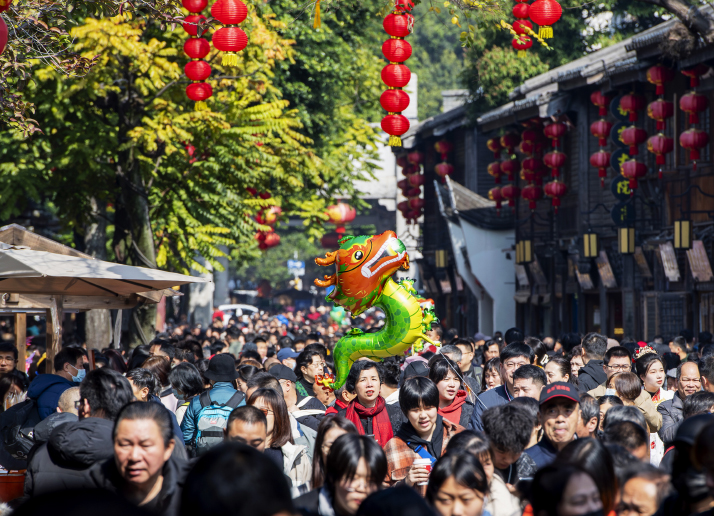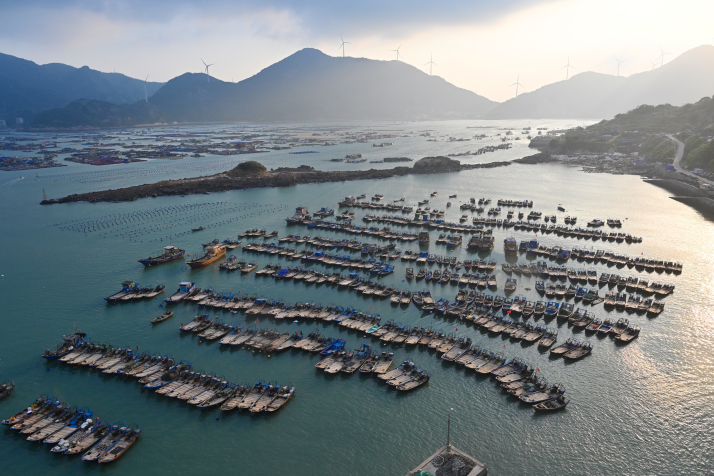| China |
| Southeast China's Fuzhou transforms history into tourism treasure trove | |
|
|
 Residents and tourists visit the Sanfang Qixiang area in Fuzhou, Fujian Province, on February 10 (XINHUA)
When Fuzhou, the capital city of southeast China's Fujian Province, is mentioned, Chinese people recognize it as the only city in the country featuring the character fu, which means "blessing," in its name. The city is celebrated for its rich fu culture, earning it the nickname "City of Blessings." "Welcome to the City of Blessings" has become a heartfelt greeting among locals, extending warm hospitality to friends and tourists alike. However, Fuzhou holds another, lesser-known distinction: It is the birthplace of jasmine tea. This fragrant brew offers a sensory delight unique to the region. Interestingly, jasmine flowers are not native to Fuzhou. They arrived via the Maritime Silk Road during the Western Han Dynasty (206 B.C.-A.D. 25). By the Song Dynasty (960-1279), local craftsmen began pairing jasmine with green tea leaves, perfecting this timeless blend. The Maritime Silk Road, originating in the Qin and Han dynasties (221 B.C.-A.D. 220) and flourishing during the Tang and Song periods (618-1279), served as a vital trade route connecting China to the world. Today, Fuzhou continues to honor this legacy, striving to become a major hub of the 21st-Century Maritime Silk Road, a foundational component of the China-proposed Belt and Road Initiative—an initiative to boost connectivity along and beyond the ancient Silk Road routes. "Fuzhou is an important hub of the Maritime Silk Road and a city full of charm," remarked Shan Jixiang, Chairman of the China Cultural Relics Academy and Director of the Academic Committee of the Palace Museum in Beijing. His statement came during the launch ceremony of the Maritime Silk Road International Cultural Tourism Festival in Fuzhou on December 6. The month-long festival features a diverse lineup of events, including a cultural and tourism dialogue, the International Cultural and Art Exchange Week, the Fujian Tourism Expo 2024, and guided tours for influencers. These initiatives aim to lift the city's cultural and tourism industries while offering visitors and residents a lively blend of tradition and modernity. A 'legasea' At the launch ceremony, Fuzhou formalized friendly cooperation agreements with Palmerston North in New Zealand, Malé in the Maldives and Dhankuta in Nepal. These partnerships mark a milestone in Fuzhou's ongoing efforts to foster international collaboration under the 21st-Century Maritime Silk Road initiative. "The Maldives has deep historical and cultural ties with the Maritime Silk Road," Ibrahim Waheed, Minister of Youth Empowerment, Information and Arts of the Maldives, said during the event. He vocalized his country's strong desire to deepen ties with China and other nations along the Maritime Silk Road. The Maldives aims to expand collaboration in areas such as culture, education and professional training, with a particular focus on tourism, hotel management and sustainable development. The shared goal is to work together toward a green and sustainable future. Waheed explained that the Maldives is a popular destination for Chinese tourists and expressed hope that this event might elevate cultural exchange and tourism cooperation between Fuzhou, Fujian and the Maldives. "I believe the most competitive advantage of Fuzhou is the rich history and cultural legacy of the Maritime Silk Road, which establishes a deep connection between China and various other countries. Fuzhou, as a historical hub of maritime trade, offers a fascinating narrative about trade and cultural exchange over the centuries, which creates an instant connection with foreign visitors," Filipe Porto, a Brazilian researcher of international relations based in Beijing, said during a dialogue on culture and tourism at the festival's launch on December 6. Fuzhou's tourism and media sectors stand to gain considerably by translating China's broader narratives, as well as local and provincial stories, into relatable and tangible examples. By focusing on small yet impactful stories, these sectors can bring these narratives to life and further illustrate the region's unique appeal, he added. "There are countless stories along the Maritime Silk Road that deserve to be told," Shan remarked. "Many countries should unite to apply for the inclusion of the Maritime Silk Road as a UNESCO World Heritage site as soon as possible, to protect this precious cultural heritage. It is a legacy shared by all of humanity," Shan said.  A fishing port in Qida Village of Fuzhou, Fujian Province, on December 4. The village has been integrating tourism and fisheries in recent years, attracting many visitors (XINHUA)
Cultural tourism Fuzhou has exerted substantial efforts to protect its cultural heritage and share the story of the Maritime Silk Road. Sanfang Qixiang (Three Lanes and Seven Alleys), a well-preserved architectural complex of the Ming and Qing dynasties (1368-1911), captures the essence of Fuzhou, a culturally wealthy city with a history spanning several hundreds of years. The protection of Sanfang Qixiang has set a national benchmark for urban preservation. The city has also diligently safeguarded its industrial heritage by establishing the Museum of Foochow Arsenal 1866 within the Foochow Arsenal Culture Scenic Area, which has become a popular tourist attraction. "This is the kind of cultural heritage protection and cultural tourism we should aspire to," Shan added. These preservation efforts also lend the city a competitive edge in developing its cultural tourism industry. According to local government reports, Fuzhou's tourism environment has seen continuous improvement. In 2023, the city welcomed 112 million tourists, exceeding the 100-million mark for the first time. This was a considerable rise in visitor numbers compared to the pre-pandemic level in 2019, when Fuzhou received approximately 94.8 million domestic tourists in total. The city's tourism revenue last year reached over 98 billion yuan ($13.5 billion), ranking among the top in Fujian. This growth also reflects Fuzhou's targeted initiatives, including the issuance of cultural tourism consumption coupons and red packets, containing discounts, vouchers, or direct cash incentives distributed via mobile apps or online platforms to encourage spending or participation in events, worth 20.3 million yuan ($2.8 million). The combined impact of coupons and packets spurred consumption surpassing 160 million yuan ($22 million). Additionally, 20,000 hot spring discount cards were distributed, generating nearly 4 million yuan ($555,000) in direct hot spring tourism spending. At the festival's launch ceremony, Guo Ningning, a member of the Standing Committee of the Communist Party of China (CPC) Fujian Provincial Committee and Secretary of the CPC Fuzhou Municipal Committee, highlighted Fuzhou's ambition to enhance cultural and tourism exchange with countries and regions involved in the Belt and Road Initiative. The city now aims to solidify its status as a world-renowned tourism destination. (Print Edition Title: Counting Its Blessings) Copyedited by Elsbeth van Paridon Comments to taoxing@cicgamericas.com |
|
||||||||||||||||||||||||||||
|